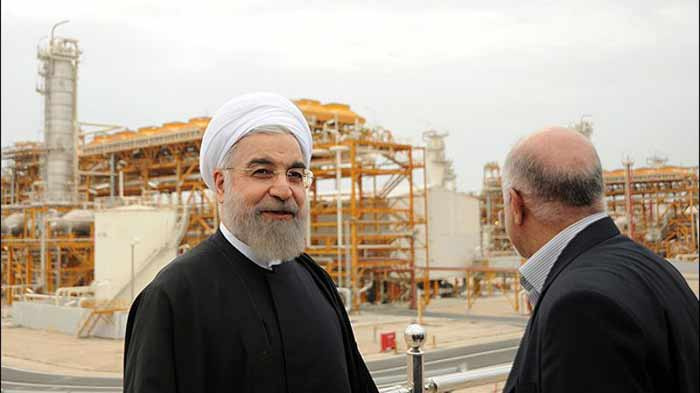Iran’s South Pars Phoenix Rises from Ashes

(Rouhani and Petroleum Minister Bijan Zanganeh in inauguration of five phases of South Pars gas field. Hasan Hosseini/Shana)
The phoenix of South Pars has risen from its ashes to inject new blood in the beating heart of Iran’s energy sector months before the Rouhani administration prepares to bid farewell to its first term in office. So writes Sara Maleki in an article published on Donyaye Eghtesad, Iran’s best-sold economy newspaper.
On Sunday, President Hassan Rouhani unveiled the statue of a phoenix made of refinery disposables, symbolizing eternity and new life, as he inaugurated five new phases of the South Pars gas field, the result of some $20 billion in investment. With the opening, Iran claims it will outpace its long-time rival, Qatar.
With the new phases now operational, Iran’s daily gas production will reach 750 million cubic meters while its gas condensates production is expected to rise to 1 million bpd. For each South Pars phase, Iran’s foreign revenues increase by 3.5 to 4 billion dollars annually, which means the investments will return to domestic economy within two years. The new phases also break the spell of oil recovery from an exceptional field, located in South Pars gas hub, named South Pars Oil Layer. Iran will be immediately able to boost its production by 35,000 bpd.
The megaproject is hailed as a great achievement in Iran’s gas production but the country will continue to lag behind Qatar in aggregated extraction. Iran’s aggregate production from the South Pars joint field has reached 1060 billion cubic meters while Qatar has so far recovered 1771 cubic meters, according to the managing director of the National Iranian Oil Company Ali Kardor.
Iran launched recovery operations in mid 1990s, years after Qatar and it lost much time under the Ahmadinejad administration. Iran has filled the gap by attracting foreign investment and technology in order to complete the project.
Following the nuclear deal, Iran has established a consortium led by Total, which aims to develop and finalize South Pars Phase 11, in addition to operationalizing a technology to resolve pressure drop issue in the field, for the first time in the region, Iran’s oil officials said. The technology is believed to significantly boost Iran’s production. “After the presidential race in the US, Total brought up issues in the talks over cooperation with Iran which we protested against. However, negotiations on preparing the contract are quickly moving forward and expected to reach a conclusion within two weeks, even though it is not yet clear when a memorandum will be signed,” Iran’s Petroleum Minister Bijan Zangeneh told reporters during a presser held yesterday in Asaluyeh.
The opening ceremony has met criticism over an alleged campaigning effort in favor of Rouhani as the country approaches its 12th presidential race. The advocates of the administration contrast the move with staged openings held under the Ahmadinejad administration, where incomplete phases were sold as complete. Zangeneh also told reporters that he had proposed another date for the opening as he viewed projects of the kind to be of national status and significance, having “many messages for the international community and the region”. Furthermore, Zangeneh appreciated efforts made by oil executives involved in the project under previous administrations.
The five phases inaugurated increase Iran’s production of condensate by 200,000 barrels per day. Other key products include ethane and liquefied petroleum gas (LPG) which respectively increased by 3 million tons per day (mt/d).
Tying the achievement to Resistance economy, Zangeneh hailed the nuclear deal saying it is more than a treaty and a turning point in Iran’s sociopolitical history. He moved on to thank President Rouhani to save the country from the ‘well of sanctions’.
Some other projects put on stream on Sunday include four petrochemical projects that were developed by private companies in South Pars. These projects will increase Iran’s petrochemical and polymer products by two million tons, worth $2b. Zangeneh said an estimated 100,000 jobs would be created with the operation of these mega projects.

